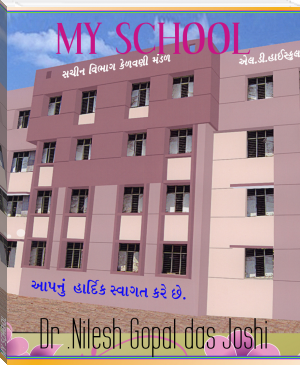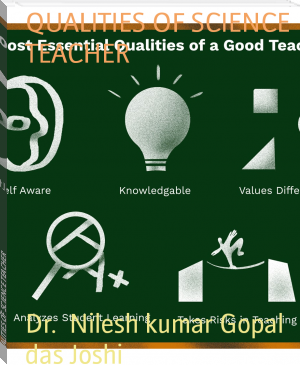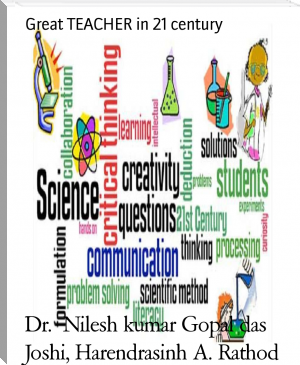MY SCHOOL by Dr .Nilesh Gopal das Joshi (beginner reading books for adults .txt) 📕

- Author: Dr .Nilesh Gopal das Joshi
Book online «MY SCHOOL by Dr .Nilesh Gopal das Joshi (beginner reading books for adults .txt) 📕». Author Dr .Nilesh Gopal das Joshi
Prevention of Malnutrition Among Children
In solving the problems of undernourishment and malnutrition, it is necessary to eliminate the causes leading to it. Malnutrition can be prevented and treated by giving children enough body-building and protective foods like milk, beans, lentils, fruits, vegetables, egg, meat and fish.
Some of the measures for checking malnutrition are:
Maintaining a balanced diet, concentrating on high-calorie food. Using inexpensive but nutritional food items and getting good food at low cost. Regular mealtimes. Well prepared and attractively served foods. Adding light snacks between meals and at bed time. Making mealtime environment calm, cheerful and encouraging. Supplimenting school meals. Imparting knowledge of personal hygiene and health. Stress on the importance of balanced, well-cooked and tasy food. Medical examination of each student at least once a year.CALORIFIC VALUES
“calorific value may be defined as the amount of heat released by a unit weight or unit volume of substance during complete combustion.”
The energy containted in a fuel or food, determined by measuring the heat produced by the complete combustion of a specified quantity of it. this is now usually expressed in joules per kilogram.our body uses calories from food for walking, thinking, breathing, and other important functions. A calorie is a metric unit of energy. The energy value of food stuffs is expressed in calories. Caloric value is determined by the presence of un-oxidised atoms of carbon and hydrogen. However a person’s specific daily calorie intake can vary depending on their age, gender and physical activity level. Men generally need more calories than women and people who exercise need more calories than people who don’t. Some of the food and the corresponding calories are given below:
Item
Quantity
Calorific value(approx.)
Egg(boiled/poached)
1
80
Bread slice
1
45
Bread slice with butter
1
90
chapatti
1
60
Puri
1
75
Idli
1
100
Cooked rice
1 cup
120
Sāmbhar
1 cup
150
CALORIC REQUIREMENTS AND ENERGY EXPENDITURE
Energy expenditure is the amount of energy (or calories) that a person needs to carry out a physical function such as breathig, circulating blood, digesting food or physical movements. your total daily energy expenditure(TDEE) is the total number of calories you can burn each day. to prevent weight gain, energy intake or calory intake must be balanced with energy expenditure.
TDEE can vary from person to person depending on body size, gender,genetics,body composition,and activity level. the total energy expenditure for a small sedentary women may be 1800 calories or less per day.but, TDEE for a large men may be 2000 calories or more.
High calorie food requires more energy expenditure to be burned off, while low calorie food offers less energy. On an average, healthy people need 2000 calories per day. Daily caloric requirements also depend upon age, weight and activity level. The Basal Metabolic Rate (BMR) is the number of calories need daily to maintain weight. Daily calorie expenditure is the number of calories one burns daily.
A regular supply of dietary energy is essential for life, and is required to fuel many different body processes. These include keeping the heart beating and organs functioning, maintenance of body temperature, muscle contraction and growth.
Things to be Avoided in Diet
Too much greasy food, hot spices and coffee: These things can cause stomach ulcers and other problems of the digestive tract. Too much sugar and sweets: These spoil the appetite, rot the teeth, can cause heart problems and may be part of the cause of intestinal cancer. Too much use of salt: Consumption of excess salt is not good for anyone. People with high blood pressure, certain heart problems or swollen feet should use little or no salt. Alcohol: Alcohol causes or makes worse diseases of the liver, stomach and nerves. It also causes emotional and social problems. Smoking: It can cause chronic (long-term) coughing or lung cancer and other problems. Smoking is especially bad for people with lung diseases like tuberculosis, asthma and bronchitis. Stomach ulcers and diabetes: These ailments require special diet.
Chapter: 31 FIRST AID
FIRST AID
What does this symbol mean…?
Although commonly associated with first aid, the symbol of a red cross is an official protective symbol of the Red Cross. The internationally accepted symbol for first aid is the white cross on a green background as shown.
MEANING OF FIRST AID
First aid is the assistance given to any person suffering a sudden illness or injury, with care provided to preserve life, prevent the condition from worsening, or to promote recovery.it includes initial intervention in a serious condition prior to professional medical help being available, such as performing CPR while awaiting an ambulance, as well as the complete treatment of minor conditions, such as applying a plaster to a cut. First aid is generally performed by a layperson, with many people trained in providing basic levels of first aid, and others willing to do so from acquired knowledge.
First aid is the immediate care of an injured or suddenly sick person. It is the care a person applies as soon as possible after an accident or sudden illness. This prompt care and attention prior to the arrival of the ambulance can sometimes mean the difference between life and death, or between a full or partial recovery.
There are many situations which may require first aid and many countries have legislation, regulation or guidance which specifies a minimum level of first aid provision in certain circumstances. This can include specific training or equipment available in the workplace such as an automated external defibrillator) the provision of specialist first aid cover at public gatherings or mandatory first aid training within schools. First aid however does not necessarily require any particular equipment or prior knowledge and can involve improvisation with materials available at the time, often by untrained persons
DEFINITION OF FIRST AID
“First aid is the emergency care or treatment given to an ill or injured person before regular medical aid can be obtained”
“First aid is the provision of immediate care to a victim with an injury or illness usually affected by a layperson and performed within a limited skill range”
“First aid or emergency care that is given to an injured or sick person prior to treatment by medically trained personal”
“First aid is the help given to a sick or injured person until full medical treatment is available”
Originator of the First Aid:
The originator of First-aid was Esmarch (1823-1908). He was born in Schleswing Holstein; became a distinguished surgeon and was appointed Surgeon General in the German Army on the outbreak of the Franco-Prussian War. The triangular bandage was invented in 1831 by Dr. Mayor of Lausanne, Switzerland.
Origin of the Term:
The term ‘First-Aid’ was adopted officially in England for the first time in 1879 by the St. john Ambulance Association. The expression “First-Aider” was not coined till 1894 and was intended to designate “any person who has received a certificate from an authorized association that he9or she) is qualified to render first hand aid.”
NEED AND IMPORTANCE OF FIRST AID
If an accident happens at the work place, you cannot be a helpless witness, since simply standing by can potentially worsens the situation. This is why it’s important to have at least a basic knowledge of first aid. First aid is the initial assistance given to a victim of injury or illness. Providing quick medical treatment until professional assistance arrives. It affords people with ability to provide help during various emergency situations First aid helps ensure that the right methods of administering medical assistance are provided. Knowledge in first aid also benefits the individuals themselves.AIMS OF FIRST AID
The main aims of first aid are to:
Preserve life- this includes the life of casualty, bystander and rescuer. Protect the casualty from further harm- ensure the scene is safe. Provide pain relief- this could include the use of ice packs or simply applying a sling. Prevent the injury or illness from becoming worse-ensure the treatment you provide does not make the condition worse. Provide reassurance- To reassure the victim and make him/her as comfortable as possible. Promote recovery- Provide appropriate emergency medical care to facilitate his/her easy recovery. Proper treatment- To assess and treat the casualty in the correct order of priority. Provide comfort- Place casualties in a comfortable position.SCOPE OF FIRST AID
The Diagnosis:The first aider should examine the causality to know the details of injuries and their nature. This is known as diagnosis. The first-aider must know how the accident or sudden injury has occurred. This information can be obtained from the victim if he/she is in a position to do so or from a witness or witnesses. This is known as the ‘history of the case’.The next step in diagnosis is to observe the ‘symptoms’ like faintness, pain, shivering or thirst.
Treatment: The diagnosis will give him an idea of treatment to be given until the doctor takes charge. With a view to prevent the condition from becoming worse, special attention should be paid to cases of severe bleeding, failure of breathing, unconsciousness and shock etc. Disposal: After rendering first-aid, the doctor should be called in to examine the casualty or victim. The next step is to send the causality to his house or to be hospital as the case may be in a suitable atmosphere. The members of the family of the victim or his relatives should also be informed at once. In any case, immediate treatment is a must.IMPORTANCE OF FIRST AID TRAINING
Knowledge of first aid promotes a healthy, secure and a safer environment, and instils confidence among people, their families, colleagues and associates. Basic first aid knowledge is very helpful in dealing with trauma situations. Not just the medical help they provide, but the confidence they exhibit is very helpful during casualties. Being trained to provide first aid is useful to oneself and society for various reasons like:
It affords people with the ability to provide help during various emergency situation:If someone swallows harmful substances or suffers health-related issues like a heart-attack, or, if a natural disaster occurs, a person knowledgeable in first aid becomes very helpful. They become an invaluable support not only to the victims, but also to professional emergency responders amd medical practitioners.
First aid helps ensure that the right methods of administering medical assistance are provided:Knowing how to help a person is just as important in emergency situations. It only takes six minutes for the human brain to expire due to lack of oxygen. Knowledge in first aid helps to provide appropriate medical care.
Knowledge in first aid also benefits the individuals themselves:Whether the emergency affects themselves directly, or involves people they live and work with, knowledge in first aid prepare an individual to deal with an emergency in a given time and place.
Knowledge in first aid helps ensure safety of both injured and involved:Dealing with emergency without proper knowledge in first-aid may lead to make the situation more badly and it may also cause further casualties. Knowledge in first aid helps to prevent the injury or illness from becoming worse. A trained person will provide temporary treatment which will keep the condition of the victim from deteriorating, till professional help arrives.
It does more than help save lives:It is true that having first aid training undoubtedly saves lives. That’s not all: giving appropriate first aid immediately can help to reduce a person’s recovery time and make the difference between the patient having a temporary and long term disability.
Increases safety:The basis of first aid training is “prevention”. It is always





Comments (0)